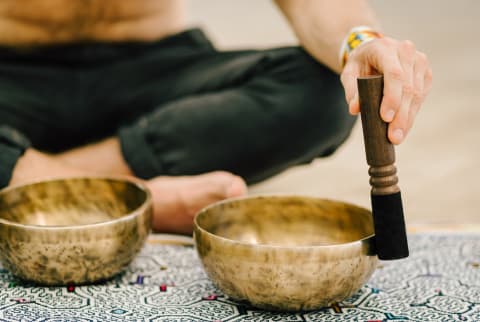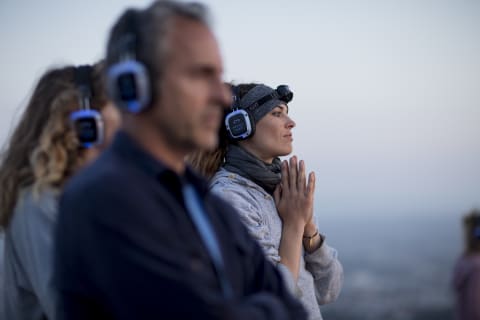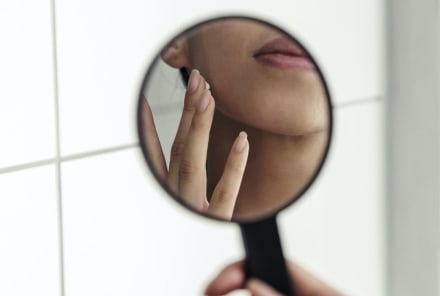Advertisement
The Latest On Why Certain Sounds Are Physically & Emotionally Healing


It's a Wednesday evening, and I'm lying in a dark room in Woom's meditation studio in downtown Manhattan, packed like a sardine next to dozens of other people who also gathered to listen to Alexandre Tannous, a legend in the field of sound healing, work through his armory of singing bowls, chimes, and gongs. As the sound meditation—another name for the more traditional "sound bath," which you might have heard of before—builds, the noises quickly start to envelop the space. They feel as physical as the blanket around my body. Their intense vibrations make way to layers and colors in my mind. It all feels very primitive, and I’m reminded that in the billions of years since the first cosmic bell (which, NASA estimates, sounded something like this), sound has largely shaped every culture around the world.
These days, we are tuning into the fact that sound experiences like these can soothe spiritual, physical, and emotional pain of all kinds—and maybe even hold the key to preventing disease.
Meet the doctors using sound as a prescription for anxiety and sleeplessness.
Ancient instruments’ ability to captivate is thanks in part to what's known as a binaural beat—a type of sound that feeds two unique frequencies into each ear. The difference between the two can cause the brain to enter a more relaxed theta state where the mind is no longer buzzing with the increasingly chaotic here and now, and can do the work of processing what lies deeper.
Binaural beats are naturally found in things like gongs and singing bowls, and you can also produce them digitally. These digitized versions are what a small handful of clinicians are now using to help their patients. For a recent study, Anna Yusim, M.D., a holistic psychiatrist with her own practice in New York City, prescribed Sacred Acoustics—recordings that strategically layer sound on a base of binaural beats—to 20 patients with anxiety disorder as an adjunct to traditional psychiatric treatment. She found that the patients who listened to the digital sound meditations experienced a decrease in anxiety within two weeks. "The fact that such changes were observed with meditation after only two weeks suggests that meditation works through a wholly different mechanism than psychotherapy," she writes of her findings, which are at press and will appear in the Journal of Nervous and Mental Disease this fall.
Karen Newell, the co-founder of the Sacred Acoustics recordings, which cost anywhere from $5 to $54 to download, theorizes that the tracks’ power comes from their ability to subtly guide people into more relaxed states. "[The tracks] lull you without capturing your attention too much," she says. "The body is relaxed, but the awareness is there. You don't realize just how relaxed your body is."

Mark Leeds, D.O., a doctor in Florida who specializes in opioid addiction treatment, also recommends Sacred Acoustics to help his patients relax. When I talked to Leeds, he explained many of the recovering addicts he sees suffer from insomnia as a side effect of their medication and have trouble staying asleep thanks to racing thoughts about the damage their addictions have caused.
"A lot of times what they're asking for is extra medication because that's what they're used to," he explained. "They're used to medicating every problem that they have... Our goal is to try to minimize medication. But when a patient tells me they can't sleep, the only thing we had historically, other than medication, was talking about sleep hygiene—which doesn't really get anybody excited."
Leeds said some patients were skeptical when he started suggesting listening to Sacred Acoustics for at least 20 minutes before bed instead. "When someone is struggling with addiction and coming off of powerful drugs like heroin and fentanyl and you tell them listening to a recording is going to do something—it can be hard [to believe]."
In the end, though, many of them found the recordings helpful: "When they put the headphones on, I think it's a different experience than they expect. I've been able to avoid giving a lot of patients additional medication to help them sleep."
Despite these promising early results, sound recordings are still not commonplace in most doctor's offices. When I asked Leeds why he thought that was, he said, "Nobody owns sound. Nobody can really say, 'I'm patenting this sound, and nobody can use it.' So there's obviously no interest from the pharmaceutical industry."
But an increasing body of medical research could mean it's only a matter of time until word gets out about the potential of accessible, inexpensive sound interventions like these.
Emerging research that explores the aging brain on beats.
One doctor working to bring sound into the mainstream clinical setting is Alexander Pantelyat, M.D., the co-founder and co-director of the Center for Music & Medicine at Johns Hopkins Hospital. If he wasn't a neurologist with a specialty in neurodegenerative disease spanning movement and cognitive disorders, Pantelyat says he'd probably be a concert violinist. He formed the center in 2015 to bridge his two passions and explore different ways to use music as medicine and improve the health of musicians.
"We're by no means the only center doing this, but we're hoping that rigorous, Hopkins-quality research will really move the field forward—which is exactly what it needs," Pantelyat says.
So far, Pantelyat and his team have conducted several studies, mostly with Parkinson's disease and dementia patients. The Parkinsonics study found that singing in a choir for 12 consecutive weeks boosted mood, lessened anxiety, and even improved movements in patients with Parkinson's disease. Another study, called Guitar-PD, concluded that guitar lessons could improve the quality of life for those with Parkinson's disease. After participating in the lessons, patients seemed to experience an increase in self-reported quality of life and mood, and reduction in anxiety for up to 12 weeks, which Pantelyat says is relatively long term for an intervention of this kind.
Music activates as many if not more parts of the brain than any other human activity.
While these studies focused on the impact of actually making music, Pantelyat is now looking into how simply listening to music can affect the brain of patients with Alzheimer's using functional MRI. "Based on what we know already, music activates as many if not more parts of the brain than any other human activity," he says. The regions of the brain that recall memory, maintain focus, and evoke emotion, for example, are all activated when listening to a familiar song.
Pentelyat's Alzheimer's study will join the small collection of existing research on how music can help the 50 million people worldwide who suffer from dementia. In April of 2018, researchers at the University of Utah concluded that dementia patients recognized and responded positively to familiar music, suggesting that music activates regions of the brain spared by the disease. "Music is like an anchor, grounding the patient back in reality," Jace King, a study author, wrote. Ongoing research out of Brown University is also finding that music could serve as a way to communicate with, and ease the emotional distress of, those with Alzheimer's.

Another study published in Cell earlier this year found that music may even play a preventive role in neurodegenerative diseases. In it, researchers at MIT found that exposing mice to a combination of light and sound that fell within a certain frequency range actually changed the way their neurons fired and reduced the buildup of tau protein in their brains—high levels of which are believed to be an underlying cause of Alzheimer's. Next, the MIT team will begin to conduct similar research on patients with early-stage Alzheimer's.
"You can see how this is an exciting time for music and medicine research,” Pantelyat says. "The overall sense is that alternative, non-medication-based treatments can really have a meaningful impact on people's lives, and in the case of music, may have minimal to no side effects.”
The booming business of sound.
As more research comes out on sound’s ability to relax our bodies and entrain our minds, the wellness world is starting to harness the tool in new ways. More than just something you hear in the background of your Flywheel or Equinox class, sound is becoming the main attraction.
You'll find it featured prominently at Frequency: A new type of immersive mindfulness studio that will open in Chelsea this fall. Co-founded by Vivian Rosenthal, a self-proclaimed "recovering technophile” who started her career at Google, the “planetarium for healing” is a dome-like space where people can go to be surrounded by light, art, and, of course, sound. “Music and frequency are weaved throughout every experience,” Rosenthal says.
There’s also Tune Studio—a "human refueling station," where people can go for 15 minutes to lie down, listen to a track, and feel its vibrations—and WAVE—a pillow-and-headset combo that vibrates to corresponding guided meditations and feels like a massage for the mind. Tune Studio has had pop-ups at Google, 1Hotel, and mbg's 2017 revitalize event, and now has a physical space in Manhattan. WAVE just launched with $5.6 million in seed funding to help answer the question, as founder Mason Levey of Y7 yoga studio fame puts it, "How can we use music to get mindfulness to as many people as possible?"

Sound as an ancient antidote to our very modern problems.
Sound, it seems, is becoming big business. But why are we just now starting to commodify something that’s been at our disposal for thousands of years?
Paul Kuhn, a sound practitioner who studied with Alexandre Tannous, thinks it could be because in our increasingly stimuli-excessive world, sound is one thing that calms our overactive minds and brings us closer to our natural state of being. Since Kuhn began holding sound meditations in 2016, he's seen a steady uptick of folks who want to use instruments like gongs and chimes at home as part of their spiritual practice. “There are a lot more people wanting to do this work," which he says is a result of “us remembering something that’s very old, that worked for our ancestors.”
Rosenthal agrees that sound’s resurgence is a rebuttal to our hyper-connected, over-scheduled days and a return to simpler times: “We’re addicted to our phones and social media. There’s an epidemic of loneliness. There’s an epidemic of prescription meds as opposed to hugging and crying and community,” she says.
Where words leave off, music picks up.
On a recent summer night in New York, I saw firsthand how music could help inspire some of the community we're lacking. Composer Murray Hidary was hosting a MindTravel event in the Brooklyn Botanical Gardens, and about 100 curious folks had gathered to ramble through the greenery while listening to him play piano through a pair of noise-cancelling headphones.
It felt like a moving meditation; an opportunity to slow down and fully engage with the senses. But unlike meditating solo, which forces you look within, this felt more like an invitation to gaze out at the collective. Seeing strangers have their own reactions to the music, knowing they were listening to the same sounds I was, made for a powerful reminder of the things we all share in a city that can sometimes feel isolating.
"I’m interested in finding that balance between providing an intimate, individual experience and a communal experience," Hidary told me after the event. He thinks of music as the language of emotions that aren't easily verbalized. It makes sense, then, that sound is sought out in an increasingly lonely age. "Where words leave off, " he smiled, "Music picks up.”
We can't wait to hear what's next.
Watch Next
Enjoy some of our favorite clips from classes
Enjoy some of our favorite clips from classes
What Is Meditation?
Mindfulness/Spirituality | Light Watkins
Box Breathing
Mindfulness/Spirituality | Gwen Dittmar
What Breathwork Can Address
Mindfulness/Spirituality | Gwen Dittmar
The 8 Limbs of Yoga - What is Asana?
Yoga | Caley Alyssa
Two Standing Postures to Open Up Tight Hips
Yoga | Caley Alyssa
How Plants Can Optimize Athletic Performance
Nutrition | Rich Roll
What to Eat Before a Workout
Nutrition | Rich Roll
How Ayurveda Helps Us Navigate Modern Life
Nutrition | Sahara Rose
Messages About Love & Relationships
Love & Relationships | Esther Perel
Love Languages
Love & Relationships | Esther Perel


















